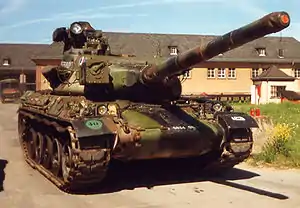105 mm Modèle F1
The 105 mm Modèle F1 (or CN-105-F1) is a French 105 mm tank gun used with the AMX-30. A shorter version of this gun called the CN-105-57, was also used in the Israeli Super Sherman.
| 105 mm Modèle F1 | |
|---|---|
 A French AMX-30B2 sporting a 105 rifled tank gun | |
| Type | Tank gun |
| Place of origin | France |
| Service history | |
| In service | 1966–present |
| Used by | Bosnia, Chile, Croatia, Cyprus, France, Greece, Israel, Qatar, Saudi Arabia, Spain, United Arab Emirates, Venezuela |
| Wars | Gulf War |
| Specifications | |
| Mass | 2,470 kg |
| Length | 5.90 metres (19.4 ft) |
| Crew | 2 (gunner, loader) |
| Calibre | 105 millimetres (10.5 cm) |
| Muzzle velocity | 1000 m/s with HEAT round 1525 m/s with APFSDS round[1] |
Design
The gun was a monoblock steel 105-millimeter (4.1 in) cannon[2] protected from bending with a magnesium alloy thermal sleeve.<[3] The F1 is fitted with a semi-automatic vertical sliding wedge breechblock, though fitted without a muzzle brake. Unlike the similar 105mm L7 tank gun, the F1 uses a compressed air scavenging system instead of a bore evacuator. The recoil mechanism uses two symmetrically opposed hydraulic brake cylinders with a single hydropneumatic recuperator cylinder.[4]
One of the unique features of the gun was the Obus à Charge Creuse de 105 mm Modèle F1 (Obus G) HEAT projectile.[3] HEAT warheads suffer when spin stabilized, a product of rifled barrels,[5] causing the French to develop the Obus G,[6] (Gresse).[7] This projectile was composed of two major parts, including the outer shell and a suspended inner shell, divided by ball bearings. This allowed the projectile to be spin-stabilized, and therefore more accurate than a normal fin-stabilized HEAT-round, while the inner shell did not move, allowing the warhead to work at maximum efficiency. The warhead, containing 780 gram hexolite,[8] could penetrate up to 400 millimeters (16 in) of steel armour and was effective against tanks at up to 3,000 meters (3,300 yd). As it combined a good accuracy with a penetration that was independent of range, it has been considered an "ideal round" for its day[6] The F1 was also designed to fire the OCC F1 Mle.60 high explosive projectile, the SCC F1 training warhead and the OFUM PH-105 F1 smoke round.[9]
Specification
- Caliber: 105mm
- Barrel Length: 56 calibers
- Weight: 2470 kg
- Length: 5.9 m
- Firing range: 3500 m
 Breech
Breech Cut-away of the tube, showing the rifling
Cut-away of the tube, showing the rifling Kinetic energy penetrator for 105 mm Modèle F1
Kinetic energy penetrator for 105 mm Modèle F1
References
- http://www.angelfire.com/mi4/armania/armor/firepower/Cannon.html
- de Mazarrasa (1990), pp. 21–22
- Ogorkiewicz, p. 8
- Source: www.army-guide.com/eng/product519.html — although the site is blacklisted for unknown reasons.
- Ferrari, p. 87
- Ogorkiewicz, p. 6
- Jeudy, p. 253
- Caiti, p. 34
- de Mazarrasa (1990), p. 23
Sources
- Caiti, Pierangelo (1978). Modern Armour: The World's Battle Tanks Today. London: Arms and Armour Press. ISBN 0-85368-412-X.
- de Mazarrasa, Javier (1990). Carro de Combate AMX-30E (in Spanish). Aldaba Ediciones. ISBN 84-86629-29-2.
- Ferrari, Giorgio (October 1988). "The "Hows" and "Whys" of Armour Penetration". Military Technology. Moench Verlagsgesellschaft Mbh (10/1988).
- Jeudy, Jean-Gabriel (1997). Chars de France (in French). Boulogne: E.T.A.I. ISBN 2-7268-8369-9.
- Ogorkiewicz, Richard M. (December 1973). AMX-30 Battle Tank. Berkshire, United Kingdom: Profile Publications Ltd. OCLC 54349455.